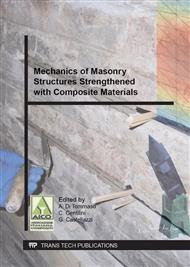[1]
Castellazzi, G., Gentilini, C., Nobile, L., Seismic vulnerability assessment of a historical church: Limit analysis and nonlinear finite element analysis, Advances in Civil Engineering, vol. 2013, Article ID 517454, 12 pages, 2013. doi: 10. 1155/2013/517454.
DOI: 10.1155/2013/517454
Google Scholar
[2]
Rots, J.G. and Invernizzi,S., Regularized sequentially linear saw-tooth softening model, International Journal for Numerical and Analytical Methods in Geomechanics 28, 821 - 856 (2004).
DOI: 10.1002/nag.371
Google Scholar
[3]
Rots, J.G. and Belletti, B. and Invernizzi, S., Robust modeling of RC structures with an eventby-event strategy, Engineering Fracture Mechanics 75, 590 - 614 (2008).
DOI: 10.1016/j.engfracmech.2007.03.027
Google Scholar
[4]
Krysl, P. and Zhu, B. Locking-free continuum displacement finite elements with nodal integration. Int. J. Num. Meth. Engng. 76, 1020-1043 (2008).
DOI: 10.1002/nme.2354
Google Scholar
[5]
Broccardo, M., Micheloni M. and Krysl, P. Assumed-deformation gradient finite elements with nodal integration for nearly incompressible large deformation analysis. Int. J. Num. Meth. Engng. 78, 1113-1134 (2009).
DOI: 10.1002/nme.2521
Google Scholar
[6]
Krysl, P. and Kagey, H. Reformulation of nodally integrated continuum elements to attain insensitivity to distortion. Int. J. Num. Meth. Engng. 90, 805-818 (2012).
DOI: 10.1002/nme.3342
Google Scholar
[7]
Castellazzi, G. and Krysl, P. Patch-averaged assumed strain finite elements for stress analysis. Int. J. Num. Meth. Engng. 90, 1618-1635 (2012).
DOI: 10.1002/nme.4264
Google Scholar
[8]
Artioli, E., Castellazzi, G. and Krysl, P., Assumed-strain finite element technique for accurate modelling of plasticity problems. Computational Plasticity XII Fundamentals and Applications, Onate E, Owen D, Peric D, Suarez B (eds. ), Barcelona, Spain, 3-5 September, (2013).
Google Scholar
[9]
Artioli, E., Castellazzi, G. and Krysl, P., Assumed-strain nodally integrated hexahedral finite element formulation for elastoplastic applications, Int. J. Numer. Meth. Engng , to appear NMENov-13-0693.
DOI: 10.1002/nme.4723
Google Scholar
[10]
Invernizzi,S. and Trovato,D. and Hendriks,M. A. N. and Van de Graaf,A. V., Sequentially linear modelling of local snap-back in extremely brittle structures, Engineering Structures 33 1617 1625 (2011).
DOI: 10.1016/j.engstruct.2011.01.031
Google Scholar
[11]
Hendriks, M.A.N. and Rots, J. G, Sequentially linear versus nonlinear analysis of RC structures, Engineering Computations 30, 792 - 801 (2013).
DOI: 10.1108/ec-may-2012-0105
Google Scholar
[12]
Di Tommaso, A. et al. Dynamic identification and seismic behaviour of the Ghirlandina Tower in Modena, Geotecnical Engineering, Napoli, (2013).
Google Scholar
[13]
Di Tommaso, A. Lancellotta, R., Focacci, F., Romaro F., Uno studio sulla stabilit`a della torre Ghirlandina, nel vol. La torre Ghirlandina a cura di R. Cadignani, L. Sossella Editore, Roma, (2010).
DOI: 10.1201/b14895-40
Google Scholar
[14]
D'Ambrisi, A., Mariani, V., Mezzi, M., Seismic assessment of a historical masonry tower with nonlinear static and dynamic analyses tuned on ambient vibration tests, Engineering Structures, 36, 210-219 (2011).
DOI: 10.1016/j.engstruct.2011.12.009
Google Scholar


